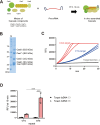CRISPR Diagnostics for Quantification and Rapid Diagnosis of Myotonic Dystrophy Type 1 Repeat Expansion Disorders
- PMID: 39565688
- PMCID: PMC11669157
- DOI: 10.1021/acssynbio.4c00265
CRISPR Diagnostics for Quantification and Rapid Diagnosis of Myotonic Dystrophy Type 1 Repeat Expansion Disorders
Abstract
Repeat expansion disorders, exemplified by myotonic dystrophy type 1 (DM1), present challenges in diagnostic quantification because of the variability and complexity of repeat lengths. Traditional diagnostic methods, including PCR and Southern blotting, exhibit limitations in sensitivity and specificity, necessitating the development of innovative approaches for precise and rapid diagnosis. Here, we introduce a CRISPR-based diagnostic method, REPLICA (
Keywords: CRISPR diagnostics; CRISPR-Cas3; Myotonic dystrophy type 1; genetic diagnosis; quantitative detection; triplet repeat diseases.
Conflict of interest statement
The authors declare no competing financial interest.
Figures




References
-
- Clark M. M.; Stark Z.; Farnaes L.; Tan T. Y.; White S. M.; Dimmock D.; Kingsmore S. F. Meta-analysis of the diagnostic and clinical utility of genome and exome sequencing and chromosomal microarray in children with suspected genetic diseases. NPJ. Genom Med. 2018, 3, 16.10.1038/s41525-018-0053-8. - DOI - PMC - PubMed
-
- Miller D. T.; Adam M. P.; Aradhya S.; Biesecker L. G.; Brothman A. R.; Carter N. P.; Church D. M.; Crolla J. A.; Eichler E. E.; Epstein C. J.; Faucett W. A.; Feuk L.; Friedman J. M.; Hamosh A.; Jackson L.; Kaminsky E. B.; Kok K.; Krantz I. D.; Kuhn R. M.; Lee C.; Ostell J. M.; Rosenberg C.; Scherer S. W.; Spinner N. B.; Stavropoulos D. J.; Tepperberg J. H.; Thorland E. C.; Vermeesch J. R.; Waggoner D. J.; Watson M. S.; Martin C. L.; Ledbetter D. H. Consensus statement: chromosomal microarray is a first-tier clinical diagnostic test for individuals with developmental disabilities or congenital anomalies. Am. J. Hum. Genet. 2010, 86 (5), 749–764. 10.1016/j.ajhg.2010.04.006. - DOI - PMC - PubMed
-
- Kamsteeg E. J.; Kress W.; Catalli C.; Hertz J. M.; Witsch-Baumgartner M.; Buckley M. F.; van Engelen B. G.; Schwartz M.; Scheffer H. Best practice guidelines and recommendations on the molecular diagnosis of myotonic dystrophy types 1 and 2. Eur. J. Hum Genet 2012, 20 (12), 1203–1208. 10.1038/ejhg.2012.108. - DOI - PMC - PubMed
Publication types
MeSH terms
LinkOut - more resources
Full Text Sources
Research Materials

